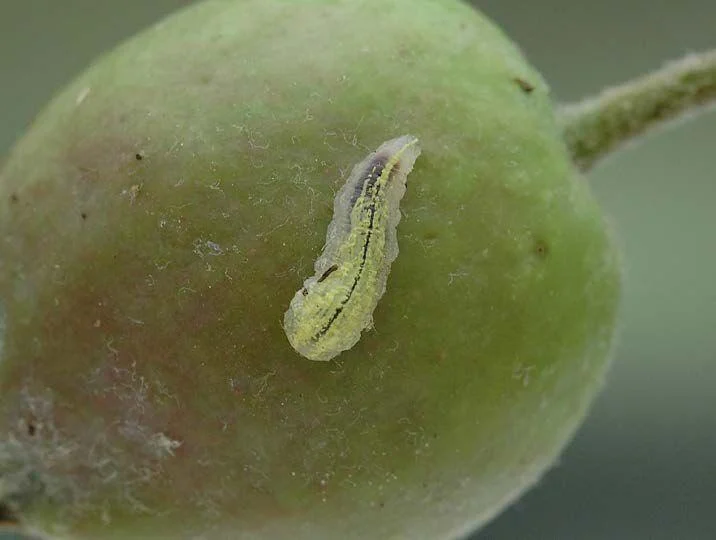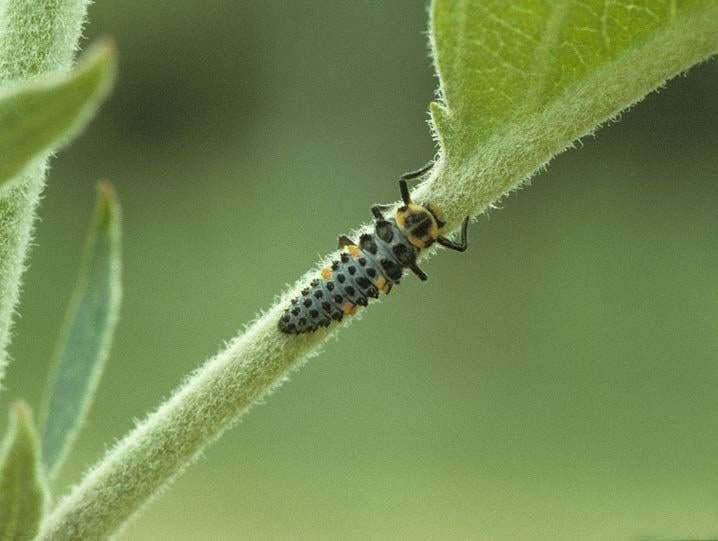Beneficial insect larvae provide natural pest control
By Julie Banken
WSU Chelan/Douglas County Master Gardener



Insects are the silent champions of the ecosystem. They pollinate flowering plants, decompose organic matter and sustain countless animals above them in the food chain. To label only a lucky few of them “beneficial” does the rest of them a disservice, but in the gardening world, “beneficial insects” are those that feed on garden pests.
Beneficial insects will soon be hard at work in gardens and yards, and it’s important to be able to recognize them. With insects, this gets a little complicated, as often when they are still larvae in their immature stages, they look nothing like the adults they will become.
Syrphid fly larvae, for example, don’t look remotely related to their parents. When they hatch out of their eggs, they are legless and blind. They can be green, gray or yellow in color, and they are voracious feeders. Just one of these small maggots can suck hundreds of aphids dry with its piercing mouthparts.
Adult syrphid flies, meanwhile, are easily mistaken for wasps or bees. They have yellow and black stripes on their abdomens and spend their time foraging for food around flowers. With a pair of gyroscope-like halteres instead of a second pair of wings, they are weirdly able to hover in one place. Syrphid adults don’t eat aphids at all, but feed on pollen, nectar and aphid honeydew with their sponge-like mouths.
Ladybugs, or lady beetles, are another beneficial insect well known to gardeners. When they are adults, these small beetles are easily recognized by their round shape and shiny, red elytra with black spots. As larvae, they are often overlooked.
Lady beetle larvae resemble a cross between a caterpillar and an alligator. Fresh out of their bright, orange eggs they look like tiny black commas on a page, but by the time they pupate they are usually about a half-inch in length. They are gray and black with orange and white markings; they hold their front legs in an aggressive stance, ready to pounce on and devour any prey they encounter.
Even if you don’t recognize the larvae of beneficial insects, it’s important to appreciate their valuable contributions to pest control. In general, predatory larvae are better at suppressing pest populations than adults for two reasons: first, their main job in life is to eat, and second, until they are adults, they don’t have wings. Without wings, they only travel as far as they can walk, crawl, or hop, so they generally stay in one place, feeding on pests until they pupate.
Unfortunately, because they eat so much and can’t fly, beneficial insects still in their larval stage are hit hard when chemicals are used to control insect pests. Even if they are not treated with a pesticide directly, they can still suffer its harmful effects, as they have no choice but to ingest contaminated prey. In addition, because they can’t fly, beneficial insect larvae are unable to escape to find food that won’t make them sick.
Larvae of all types can become collateral damage even when “selective” chemicals are applied to kill pests. For example, insect growth regulators are a type of insecticide that targets the hormones of developing insects. These chemicals are considered selective because they act on arthropods and not other animals. Not only do they keep adult insects from reproducing, growth regulators stop insect eggs from hatching and prevent juveniles from molting. Insect growth regulators act on all insects, whether they are pests or not.
Insecticidal soaps are another type of chemical often recommended for use in the garden. Labels on these insecticides proclaim they are effective at killing soft-bodied arthropods. Many garden pests — such as aphids, thrips, mealybugs and mites — are soft bodied, but the larvae of all other insects are soft-bodied, too. Soap dissolves the protective cuticle on their soft exoskeletons, and they die by drying out.
Adult insects lay eggs in places where they know their offspring will have enough food. That means attracting beneficial species to your garden requires allowing pest insects to live there, too. The best way to attract beneficial insects is to keep your yard free of chemicals. Let beneficial insects do the work for you and naturally keep prey populations low.
Foregoing chemical treatment and tolerating the presence of pest insects ultimately creates a healthy home for all the beneficial insects out there, not just the garden predators. If you find beneficial larvae in your garden, be sure to celebrate. These young insects are a sure sign of a healthy garden ecosystem.
A WSU Chelan and Douglas County Master Gardener column appears weekly in The Wenatchee World. To learn more, visit bit.ly/MGchelandouglas or call (509) 667-6540.
